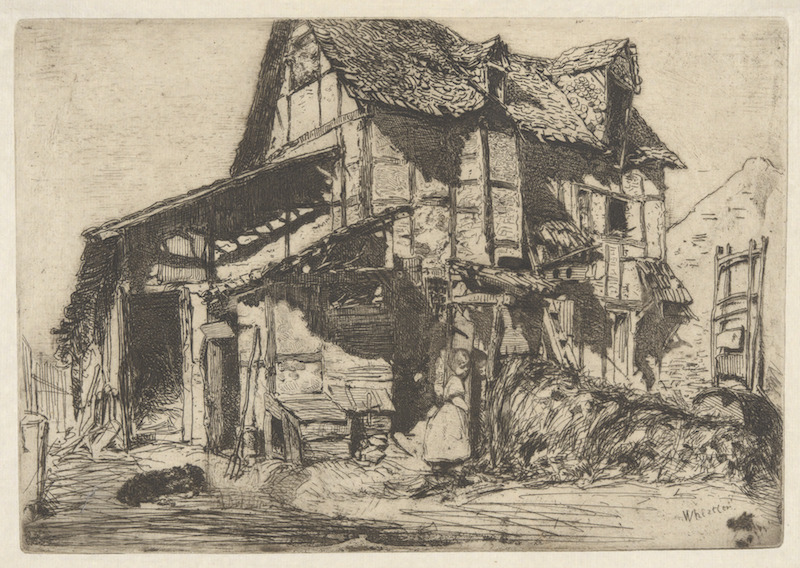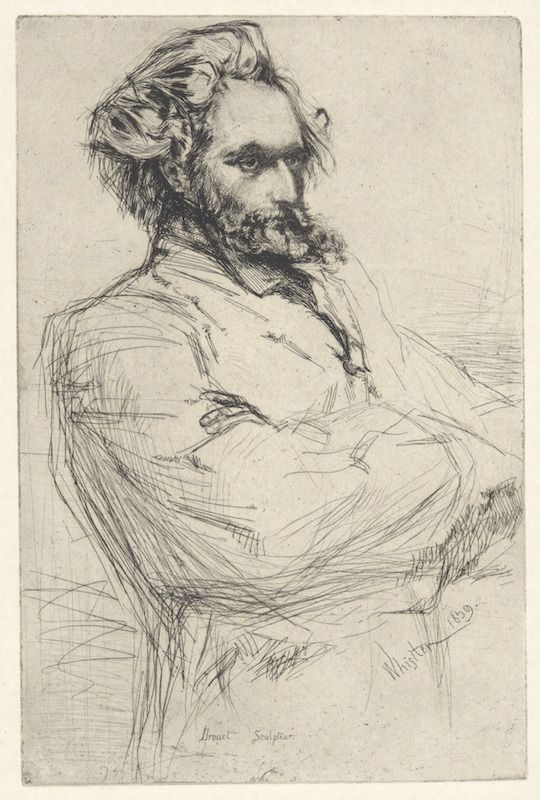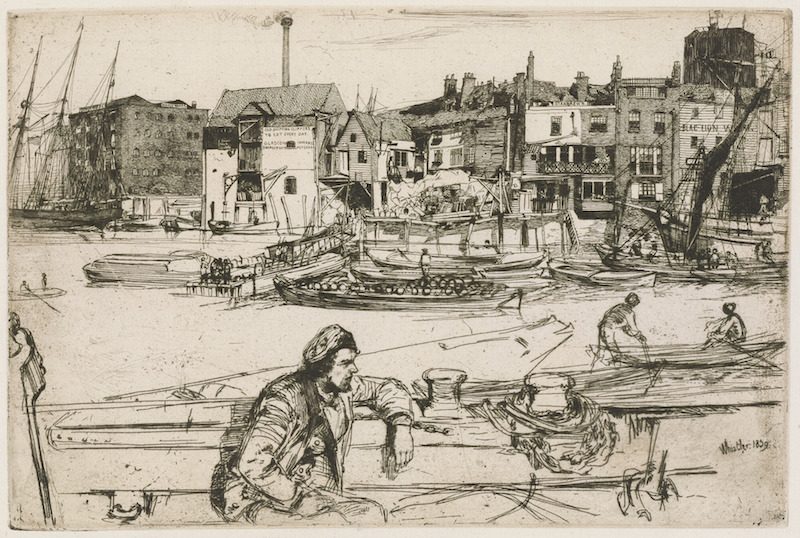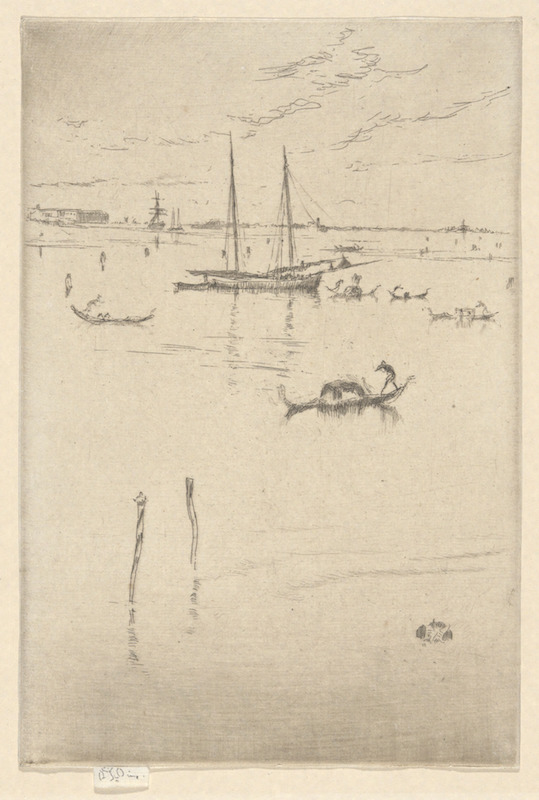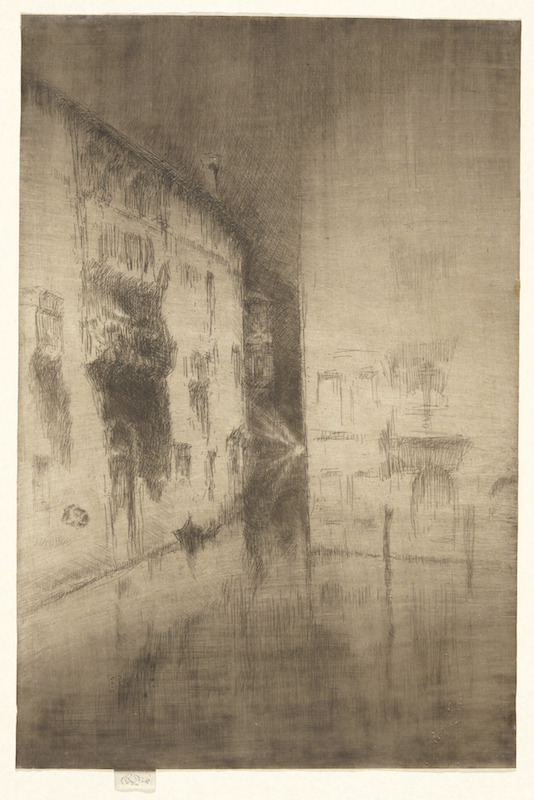“….he expresses regret that he did not study under Ingres, whose work he may have liked moderately, but from whom he would have learned to draw: which was an absurd piece of modesty for he drew better than Ingres, as his etchings prove.”
Elizabeth Robins Pennell and Joseph Pennell
Notwithstanding the adulatory tone taken by his friends and biographers, the Pennells, James Abbott McNeill Whistler was indeed a great etcher, and it was the print process more than any other that allowed him to display the expertise and delicacy of his linear stroke. The painter best known for artful evanescence may still surprise us for the exactness of drawing that characterizes his prints.
This is a good time for fans of Whistler and devotees of drawing, for Whistler in Paris, London, and Venice is on display at the Yale University Art Gallery until July 19. As the title suggests, the show is based upon Whistler’s three formal sets of etchings—the French, Thames, and Venice—which represent, in turn, student work that was influenced by other masters, his own emergent originality, and the products of his full maturity. Although much of the work in the exhibition is drawn from Yale’s collection, the show is confined neither to examples from the three sets, nor to work by Whistler: there are numerous pieces by his masters and contemporaries, and even one of his Venetian pastels. The latter is considered so susceptible to light that it’s covered by a cloth drapery, which the viewer lifts in order to see the work. It’s an inadvertently Duchampian touch that Whistler would have liked.
In the mid-1850s, Whistler experimented with etching alongside his brother-in-law Francis Seymour Haden, who collected prints by the Old Masters and encouraged the younger artist to work from nature. With these influences fresh in his mind, Whistler set out on a sketching trip through France and the Rhineland; twelve of the resulting prints comprise the French Set. There are echoes of the Dutch masters, and an attention to detail he would modify, if not relinquish, in due time. The Unsafe Tenement (1858) has a geometric, monumental mass viewed in harsh sunlight that is nearly unique in his oeuvre. Drouet, Sculpteur (1859) is a portrait completed in two sittings. The magnificent head, rich in detail, takes on even more solidity when contrasted with the open handling of the torso and arms.
Soon after his return to London, Whistler embarked on the Thames Set, which included sixteen etchings that parallel the subjects of his paintings, ca. 1860. More than any artist, Whistler owned the Thames waterfront. The London prints reveal an interest in the specificity of architecture, ship riggings and the working-class denizens of the docklands. Courbet’s influence is apparent in the insistent realism, yet Whistler possessed a more sophisticated eye, and his compositions are more complex than in the French Set (see Black Lion Wharf and Billingsgate). The crowded designs of these etchings would in a few years give way to Whistler’s mature aesthetic, wherein detail is subsumed by fog and night.
Bankruptcy forced Whistler to Venice in 1879, in the form of a much-needed commission to produce a set of a dozen etchings for a London dealer. The trip turned out to be unexpectedly productive: he remained in Venice for over a year, producing about fifty etchings, twice as many pastels, and several paintings. Among the legions of artists who besieged the city in the second half of the 1800s, Whistler was unique in his focus on backwaters and impoverished interiors, rather than picturesque vistas—though his aesthetic had changed, a connection to working class themes remained. (Another quality that never left Whistler was his irreverence: encountering a disciple of John Ruskin who was painting an elaborately finished, 7½-foot-wide canvas in St. Mark’s Square, Whistler supposedly pinned to his back a note reading, “I am totally blind.”) A great sense of restraint and an often dreamlike quality characterize the two Venice Sets of 1879-80, where those parts of the plate left untouched are as important as the deliberately descriptive passages. The Little Lagoon is a lesson in brevity; in Nocturne: Palaces, lines are woven to a velvety effect.
The Yale show preserves a welcome sense of intimacy, abetted by the small scale of the works and sparse attendance on the intermittently snowy afternoon I was there. If one is to fault the exhibition, it is for lack of an accompanying published catalogue. The only corrective is to return and view the show again. In the trenchant yet delicate draftsmanship of his etchings, Whistler’s monogram of a barb-tailed butterfly finds its most fitting expression.
Whistler in Paris, London, and Venice continues at the Yale University Art Gallery through July 19, 2015.
Whistler often supplemented his etchings with drypoint, which produces painterly effects. Because the resulting burr erodes so rapidly, only a few good impressions could be drawn from a plate. J.A.M. Whistler, Drouet, Sculpteur, 1859. Etching. Sheet: 30.2 x 19.7 cm (11 7/8 x 7 3/4 in.); strike 9 x 6. Gift of Mrs Emerson Tuttle, in memory of Theodore Sizer, 1967.83.7. Photo: Yale University Art Gallery
The Thames Set etchings feature complex designs and a flattening of space that evidence Whistler’s increasing interest in Japanese art. Black Lion Wharf, from the Thames Set (A Series of Sixteen Etchings of Scenes on the Thames and Other Subjects), 1859. Etching. Sheet: 22.9 x 35.9 cm (9 x 14 1/8 in.); strike 5 7/8 x 8 3/4. The Walter R. Callender, B.A. 1894, Memorial Collection, Gift of Ivy Lee Callender, 1962.45.538. Photo: Yale University Art Gallery
J.A.M. Whistler, Billingsgate, 1859. Etching. Sheet: 26.0 x 36.5 cm (10 1/4 x 14 3/8 in.); strike 6 x 9 in. Gift of Allen Evarts Foster, B.A. 1906. 1965.33.578. Photo: Yale University Art Gallery
Referring to The Little Lagoon, Whistler scholars Ruth Fine and Margaret MacDonald wrote, “Whistler drew on the copper plate with an extraordinarily light hand in precisely the right places, structuring a great distance in space.” J.A.M. Whistler, The Little Lagoon, from the First Venice Set (Venice, A Series of Twelve Etchings), 1879-80. Etching on antique handmade laid paper dating to 1670s and containing watermark of Dutch paper maker, Pieter Van der Ley. 23.5 x 15.3 cm (9 1/4 x 6 in.) (sheet). Frederic George Achelis Memorial Collection, Gift of Miss Elizabeth Achelis, a lover of prints, 1927.73. Photo: Yale University Art Gallery
J.A.M. Whistler, Nocturne: Palaces, from the Second Venice Set (A Set of Twenty-six Etchings), 1879-80. Etching and drypoint on laid paper. 30.2 x 19.7 cm (11 7/8 x 7 3/4 in.) (sheet). Frederic George Achelis Memorial Collection, Gift of Miss Elizabeth Achelis, a lover of prints. 1927.76. Photo: Yale University Art Gallery


